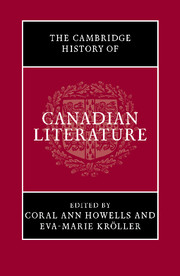Book contents
- Frontmatter
- Introduction
- PART ONE OLD AND NEW WORLD, LA NOUVELLE-FRANCE, THE CANADAS, DOMINION OF CANADA
- PART TWO THE POST-CONFEDERATION PERIOD
- 7 Post-Confederation poetry
- 8 Writing by Victorian naturalists
- 9 Short fiction
- 10 Bestselling authors, magazines, and the international market
- 11 Textual and social experiment in women’s genres
- 12 Canada and the Great War
- PART THREE MODELS OF MODERNITY, POST-FIRST WORLD WAR
- PART FOUR AESTHETIC EXPERIMENTS, 1960 AND AFTER
- PART FIVE WRITING IN FRENCH
- Bibliography
- Index
- References
10 - Bestselling authors, magazines, and the international market
from PART TWO - THE POST-CONFEDERATION PERIOD
Published online by Cambridge University Press: 28 September 2010
- Frontmatter
- Introduction
- PART ONE OLD AND NEW WORLD, LA NOUVELLE-FRANCE, THE CANADAS, DOMINION OF CANADA
- PART TWO THE POST-CONFEDERATION PERIOD
- 7 Post-Confederation poetry
- 8 Writing by Victorian naturalists
- 9 Short fiction
- 10 Bestselling authors, magazines, and the international market
- 11 Textual and social experiment in women’s genres
- 12 Canada and the Great War
- PART THREE MODELS OF MODERNITY, POST-FIRST WORLD WAR
- PART FOUR AESTHETIC EXPERIMENTS, 1960 AND AFTER
- PART FIVE WRITING IN FRENCH
- Bibliography
- Index
- References
Summary
In the late 1860s and 1870s publishers and writers in the new Dominion were paying close attention to the dramatic changes affecting the conditions of print culture. Many were industrial and had international implications; collectively, they created a new range of opportunities to be tested and exploited. This chapter considers various ways in which, quite apart from the vexing matter of copyright protection, these new conditions affected Canadian writers and publishers. By the 1880s, in fact, the era of the bestseller had dawned and the scramble to profit from new publishing opportunities was evident both in the United States and Canada.
In the wake of the American Civil War, it was clear that, in New York and Boston, newspapers, magazines, and books were being printed faster and in much greater volume than ever before. Technical improvements abounded. Paper was cheaper, automated typesetting was increasingly efficient, woodcuts were being integrated more effectively (the application of photographs was imminent), and large steam presses meant printing forms could operate day and night. Distribution was faster and advertising aggressive both within the printed text and by agents seeking to develop national markets. Newspaper production and book publishing could now occur on an unprecedented scale and at much reduced costs per unit. As well, in the northeastern United States large niche markets were opening up and expanding, although the conservative media of the time deemed much of this new production cheap and merely popular – that is, non-literary and of lesser consequence than traditional publications.
- Type
- Chapter
- Information
- The Cambridge History of Canadian Literature , pp. 185 - 203Publisher: Cambridge University PressPrint publication year: 2009



